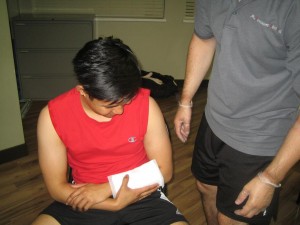Sprains are a common injury and will usually cause damage to the soft tissues. When one experiences a sprain, the joint that is involved has its ligaments torn. Such an injury may be acute or chronic. An acute sprain is one that occurs suddenly while a chronic sprain is one that worsens as the days go by. Due to these differences, such an injury can take anywhere between a fortnight and three months to heal. The rate of healing will also be influenced by age of the patient as well as the forms of treatment availed following occurrence of the injury.
[youtube url=”https://www.youtube.com/watch?v=oa6QANkF4zg” width=”220″]What are some of the causes of sprains?
Joints contain ligaments which are a form of connective tissue that hold the joints together. The joint is surrounded by a membrane that contains synovial fluid. When these ligaments get torn, the result is a sprain. There are places which are more prone to spraining, and they include the ankle, the wrist as well as the thumb.
What are the symptoms of sprains?
- The affected area will be painful.
- Spraining often leads to swelling of the area around the affected joint.
- Some patients will attest to the fact that the joint area becomes stiffened.
- Depending on the extent of the injury, there will be decreased efficiency in terms of functionality.
What are the different degrees of sprain injuries?

Sprain injuries are classified differently depending on the extent of damage. Below are the different classifications:
- In Grade 1 sprain injuries, the affected area is slightly painful and will often be swollen, but functionality remains intact.
- Sprains classified as grade 2 injuries will be painful and noticeably swollen due to the fact that many fibers are torn. In many cases, there will be significant loss of function and weakness in the affected region.
- Grade 3 sprain injuries are the most severe since soft tissue is extremely torn. There is also loss of function, and such injuries will require emergency care.
What is the first aid for sprain injuries?
- Cease engaging in the activity that caused the injury.
- Ensure that the affected area is at rest to prevent further strain on the joint.
- Ice packs will come in handy, so make sure that you have a number at hand. When placing the ice pack, ensure that it does not come into contact with skin. Do this by placing a cold towel between the ice pack and the skin.
- Stretch the bandage to cover the affected area adequately; making sure that it is well tied.
- Raise the affected area if possible.
- Keep off exercising and massaging the affected area as this could increase the swelling.
- If the condition does not improve within 24 hours, ensure that you see your physician for medical attention.
Treatment options for sprains may include the following: pain medication (but make sure you consult your physician), manual techniques as well as electrotherapy. This will depend largely on the extent of injury.
